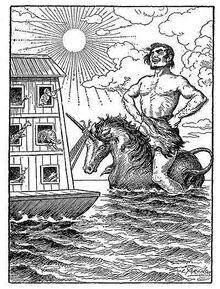Re'em (Hebrew: רֶאֵם) is the biblical unicorn. The Bible mentions it seven times, always in the context of immense strength, indomitability and a long horn or horns rising in the direction of the sky. It is spoken of without explanation, the readers being expected to know the animal perfectly well. In time, however, the real identity of the re'em was forgotten. The Septuagint translates the word as μονόκερως (monoceros). It is unknown whether the authors really considered the re'em and the unicorn to be the same or simply believed the latter would be more familiar to the readers.
Jewish folklore[]
Rabbah bar bar Hana said he once saw a re'em one day old, which was as big as Mount Tabor, with the length of forty parasangs (about 150 km or 90 miles). Its stretched out neck was three parasangs (11 km/7 mi) and the place where its head rested was a parasang and a half (5.5 km/3.5 mi). It cast a ball of excrements and blocked the Jordan.[1] This story is one the "tall tales" of RBBH, believed to be veiled commentaries on the political and social conditions of his time. Gaon of Vilna believes it a parable for an overly conceited young Torah scholar, who never receives the reputation he thinks he deserves.[2]
At any given time, there are only two re'em in existence, male and female. Had there been more, the world could hardly have maintained itself against them. They live in the opposite sides of the world: one in the west and the other in the east. Every seventy years they come together and mate. After copulation, the female bites and male in the neck and he dies of the bite. The female becomes pregnant and remains in this state for no less than twelve years. In the year preceding her delivery she is unable to move, but the saliva flowing from her mouth makes the ground around her fertile and bear enough food for her to sustain herself. Finally she gives birth to twins: one male and one female, and dies. Immediately after birth one of the young re'em goes westward and the other eastward. They live separately and meet again after another seventy years, just like their parents did.[3]

Right before the Noah's flood, a re'em was brought to Noah by a giant called Og. Even though the animal was very young, it was too large to fit inside the ark. Therefore, Noah tied its horn with a rope to the ship, allowing it to swim next to it. Only the tip of its nose fit inside, but it was enough for it to breathe and be fed. Og also survived the flood by sitting on the re'em's back.
When King David was still a shepard, he once climbed atop the re'em's back, mistaking it for a mountain. He only then noticed his mistake when the animal stood up. He started praying to God, promising to build a temple for him, one hundred ells in height, as high as the animal's horn. Thereupon, God sent a lion. The king of beast demanded the re'em bow to him and it complied. When the re'em lowered its head, David jumped down, but then the lion started chasing him. David prayed again and God sent a deer to him. David jumped on the deer's back and was able to escape to safety. Years later, when he became the king of Israel, he still remembered this event and thus he wrote in the Psalms: "Save me from the lion's mouth: for thou hast heard me from the horns of the unicorns."[4]
Origin[]
Some biblical scholars like Rabbi Solomon and David Kimhi believe the word to come from רוֹם (róm), which means "height", "altitude" and refers to the horn.
The original meaning of the word has been a matter of heated debate. In Middle Ages "unicorn" was synonymous with "rhinoceros" and so, according to Saint Gregory, re'em has the horn on the nose. The Vulgate sometimes translates the word as "unicornis" and sometimes as "rhinoceros".
Rabbi Saadia Gaon, followed by Samuel Bochart, believed the re'em to denote an oryx (which, according to Aristotle, was single-horned), basing it on the similarity to Arabic ريم (rīm). In Modern Hebrew ראם means "oryx".
Since Johann Ulrich Duerst, modern scholarship believes for the original re'em to be the extinct species of wild cattle called aurochs, known as 𒄠 (rimu) in Akkadian. New translations of the bible use "wild ox" whenever re'em is mentioned.
References[]
- ↑ Bava Batra 73b
- ↑ Slifkin, Natan; Sacred Monsters, p. 53
- ↑ Louis Ginzberg, The Legends of the Jews, vol. I, ch. I
- ↑ Gertrude Landa, Jewish Fairy Tales and Legends: From Shepherd-Boy to King